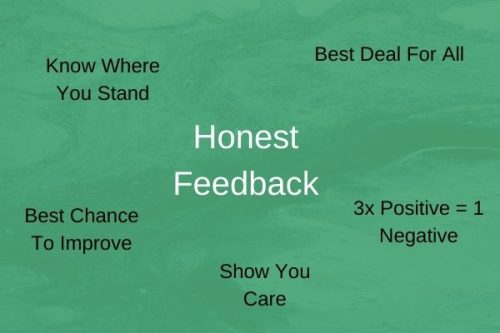7 Steps to Give Performance Feedback to Team Members

Giving honest useful feedback to employees or team members for many managers and leaders is not an easy task. If feedback is critical, we are worried about offending the other person, creating resentment, ruining relationships, and making our own lives harder at work. When we are giving compliments and positive feedback how do we do this to make sure our team members or employees keep doing it and maybe do even better?
These 7 steps to giving really useful performance feedback – positive and negative – to employees and team members will help them improve what they do and in turn they will appreciate the feedback.
It can feel easier and safer not to give feedback. If you don’t give feedback, you probably won’t offend others. I can understand why this can be appealing when you have to work alongside your team members most days, and keeping a good professional relationship is important.
This Article Covers:
7 Steps to Performance Feedback
- Performance feedback is a must to increase team member engagement
- Give performance feedback to help team members
- Give performance feedback quickly
- Be 100% Honest with your performance feedback
- Make Performance Feedback Clear and Specific
- Base performance feedback on actions not personalities
- Create A Two Way Street
As manager, giving feedback is part of the job description. You have to give feedback on the performance of your team members if you want:
- the team’s performance to improve;
- to be promoted and look after a bigger team
- to been seen as an effective manager
- to keep your team happy and developing on a personal level
All very good reasons to personally overcome the fear of giving feedback.
1. Performance feedback is a must to increase team member engagement
If you are new to management, giving performance feedback is probably something that you are nervous about. I certainly was in my early management days. The best way to get more comfortable giving feedback is to practice. And by practicing you get better at delivering feedback.
The worst thing you can do is not give any feedback to your team members.
Research by Gallup showing the impact of no feedback – 40% of employees are actively disengaged compared to 1% who receive positive feedback and 22% who receive negative feedback.
As a manager, if you want to do your job well, you must give feedback and this study confirms this.
So let’s talk about how to give performance feedback to team members.

2. Give performance feedback to help and develop team members
Why you give feedback to your team members matters.
If you are giving feedback because that is what you have been told to do and you have read that is what managers should do, it is a lot less your feedback will be very useful or taken in by the other person.
When you are genuinely trying to help the other person improve and do this consistently – by sharing advice, mentoring, and coaching, and pointing out what has not gone well and why – it will be obvious to the other person and they:
- Are much more likely to listen and take in what you say
- Be grateful that you put the effort into trying to help them, even if the message was tough
- Try to put into action a different approach or behaviour
Genuinely trying to help does not guarantee the employee or team member will change. They have to choose to use that feedback to improve. Or they may ignore you.
Help Them to Develop
As you genuinely try to help each team member, word will quickly get around that you are there to help the team and support the team, rather than just tell them what to do. I mean who doesn’t want to work for a manage that cares, that is trying their best to move our career forwards!
And if you are worried that the extra effort of really thinking about the feedback you give and how you are going to give it is wasted – I promise you that as a manager you will be rewarded by a much more engaged and motivated team. Enthusiastic teams deliver a lot more, which means you as the manager of that team get quick career progression.
Put the time and effort in to help. Everyone, especially you, will be a lot better off.
3. Give performance feedback quickly
Performance feedback – good and bad – decreases in usefulness over time! Don’t wait, give feedback quickly.
Imagine you didn’t understand something, made a mistake but didn’t know you had etc. You would want to know as quickly as possible so you could change it. What would be the point in telling you a week later, or at your next performance appraisal.
If a team member was making repeated mistakes, you would want them to correct it as quickly as possible. And if a great piece of work had been done, tell them quickly so you encourage them to do more great work tomorrow not next year.

Give yourself enough time to prepare what you are going to say and how you are going to say it, gather whatever information you need to refer to during the conversation and then give the performance feedback.
I really like having one-to-one meetings with my direct reports each week as this give both of us time in private to have performance feedback conversations. The longest I might wait before giving performance feedback is a week as a result.
Don’t wait to give performance feedback whether positive or negative. Give feedback while the action that led to the feedback is still fresh in everyone’s mind.
4. Be 100% Honest with your performance feedback
Being very honest with your performance feedback is a lot harder than most people think.
Watering down negative feedback “to spare people feelings” and avoiding any hint of conflict is commonplace in the workplace. And providing general wishy washy positive and negative performance feedback as it saves us really thinking about what to say or to gather information together than would make the performance feedback more useful.

Don’t beat around the bush. Don’t sugar coat your feedback or water it down. Try to be as honest as you can as this makes the performance feedback a lot more useful.
Do be considerate and empathetic in how you get your message across. Do adjust your delivery style based on the person you are giving the performance feedback to. After all, if they are so angry or annoyed at you because of how you give feedback, they are unlikely to take in what you are trying to tell them.
Give as honest feedback to the team member as possible as this gives them the best chance to improve what they do if it is not up to the standard required, or if their performance is great, for them to replicate what was great about it.
Don’t shy away from the more difficult conversations. No-one finds them easy, even if you have 20 years’ experience of managing teams. Being honest means talking about the areas that the other person will not like hearing about or may resent you for raising it or dislike you because you bring it up.
In my experience, why you bring up negative performance feedback and how you do are the key to keeping the team member on side. The actual reason for the feedback is less of an issue.
And lastly, the research shows that to keep a team member happy, you need to compliment them about 3 times as much as criticising them. So keep an eye out for good work and behaviours and shout about them. That said, don’t step away from the harder conversations either.

5. Make Performance Feedback Clear and Specific
Make your performance feedback specific. If you do this then you are much more likely to have a very clear message and the other person is
- A lot more likely to take in what you say
- Be less resentful about receiving negative feedback
- Feel even better about getting positive performance feedback
- Find your feedback useful in doing their job
I always hated general messages like: “Well done, that was a good people of work”. How is this going to help me repeat the good work. I want to know exactly what part of the work was good and why. I want the specifics so I can repeat again and again.
If the message was – “I need you to improve X”, I would want to know exactly what X was, be given an example of what good looked like and the opportunity to ask questions about how I need to change what I do so I can deliver X properly.
Make your feedback specific. Provide detailed explanations about what was good or bad, about what needs to be changed or replicated. Explain why you are giving the feedback you are. What are the knock on impacts – good and bad – to other teams.
Show the team member what good looks like rather than just tell them if possible. Be specific and the person you are giving performance feedback to will be so much better placed to improve what they do or repeat what they have done.
6. Base performance feedback on actions not personalities
Focus your feedback on the actions or lack of actions that a person has taken. Try to avoid giving general feedback based personality traits of the other person.
Focusing on actions is a lot less personal and less emotionally charged. Feedback on actions is easier to receive without causing upset, anger, resentment etc. The feedback is about something you did not directly about you as a person.
The person receiving feedback is also likely to be a lot more willing to change their actions. Getting them to change who they are is not going to work in 95%+ of cases.
A few examples
of action focused performance feedback:
“The analysis you undertook on customer XF had a couple of mistakes in it. Let me take you through each and how you can avoid these mistakes going forward. The first is …”
“Yesterday I understand you stated to Jill that her work was rubbish in front of the team. That type of language is not helpful to Jill and is unacceptable. You should have taken Jill into a meeting room and then explained what she had done wrong and how she could go about fixing it”
Examples of poor performance feedback:
“Your attention to detail is just not good enough. I want you to improve it”
“The way you speak to you team is demotivating and rude. I need you to change it”
Another approach to consider is using questions to lead the team member through the issues. Get them to think about and tell you the issues rather than you telling them in the first instance.
An example set of question
could be:
- “What went well in the analysis of customer XF?”
- “What areas of analysis might you have missed in your analysis?”
- “What steps did you take to check your calculations and conclusions?”
- “What would you do differently next time?”
Asking questions can be a good approach to really get buy in and drive the learning home.
Keep your performance feedback about the actions or lack of them, or about what they could have done rather than about personal traits or about them generally where at all possible.
7. Create A Two Way Street – Ask for feedback on your performance
And finally, ideally performance feedback should be a two way street. If you are giving feedback to improve the performance of team members, then it makes just as much sense to get feedback to improve your performance as a manager or leader.
As a manager, getting useful feedback from your boss can be hard, getting useful feedback from your team is even harder. We all have a natural tendency to present good news to our managers – after all they control or influence our bonuses, our promotion prospects, what projects we work on and so on. It can be scary to give honest useful feedback to our manager.
So as a manager, if you want to get useful feedback, then make it as easy as possible for your team to give you feedback.
Ask them regularly for feedback.
If they are only giving you positive feedback, then ask “what is the one thing that you think I should improve about what I do?” or a similar type of question.
When they give you feedback, listen carefully, thank them, and then go away and think about what has been said.
If it has been critical – don’t get defensive, don’t justify why you have done what you have done etc. If you think that person has a point, then work on changing what has been highlighted.
Other very useful options for getting useful feedback as a manager are:
- Anonymous 360 degree feedback surveys
- Third party coaching with a qualified coach
- A third party mentor
If you want to improve your management and leadership skills, then getting feedback from any source is a very good idea. If you don’t know what is going well and what is not, it is hard to change what you do to further improve.

The more you practice, the more comfortable you will get and the better you will be at delivering useful feedback to team members.
A great team performance means your career will progress faster. Learning how to give specific useful feedback is a great skill to develop and a great investment in your career progress.
If you’ve found this article useful please share it on social media or with friends.









